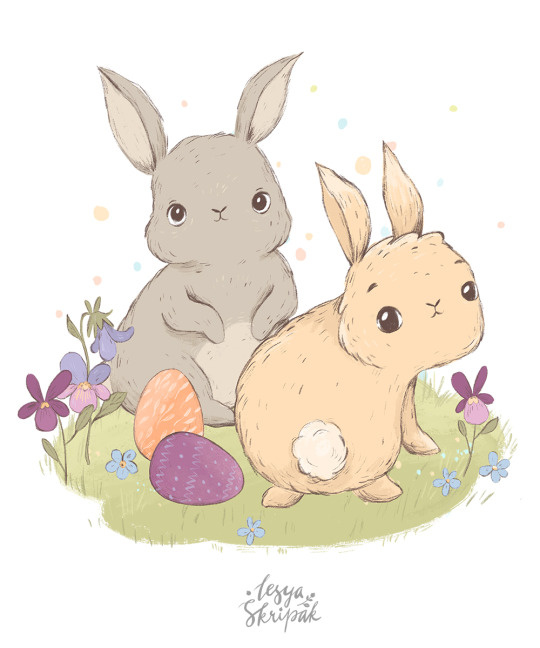#easter hare
Explore tagged Tumblr posts
Text
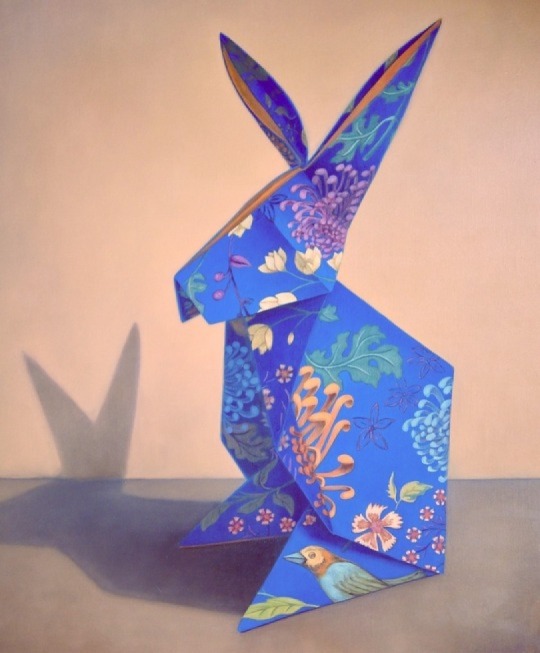
Hello Hare - Erica Scheper
Dutch, b. 1974 -
Oil on canvas , 120 x 100 cm.
398 notes
·
View notes
Text
Green spring: The Easter Bunny
THE EASTER BUNNY
Category: Easter folklore
When people think of Easter, they usually consider that there are two sides to the celebration – the religious Easter, about the resurrection of Jesus Christ in Christian religion, and the secular Easter, which is all about finding chocolate eggs. But it might surprise you to learn that the Easter eggs – and the Easter bunny – are not as “cut-off” from the religious celebrations as one might think…
You see, the very tradition of the Easter eggs comes from a Christian custom of sharing eggs dyed red – dyed red to symbolize the blood shed during the crucifixion of Jesus, the death of the Messiah, but eggs to symbolize the resurrection of the Christ upon Easter day. While in most of the “Western world”, the religiousness of the eggs kind of disappeared – as they became plastic eggs and chocolate eggs hunted down by children in gardens and parks, they kept all of their religiousness in Eastern Christianity (Orthodox Christianity), where they are still blessed by a priest. In fact, the very reason the Easter eggs are chocolate eggs now was cause of the practice of Lent – forty days of fasting before Easter during which Christians were forbidden to eat rich foods, such as meat, eggs or sweets. Since Lent ended with Easter, people started to create chocolate eggs to have the pleasure to eat back two of the forbidden “Lent foods” (eggs and chocolate) at once. And similarly, it might surprise you, the Easter Bunny started out as a religious figure…
The Easter Bunny first appeared as the “Easter Hare” among the Lutherans of Germany in the second half of the 17th century – he was a moral figure very similar to what Santa Claus was for Christmas, that is to say that the Easter Hare was supposed to watch over and decide which children were naughty and which children were nice during Eastertide (the Easter season). Nice children would then receive gifts from the Easter Hare – colored eggs, candies and/or toys. The Easter Hare was especially supposed to place the eggs in special nets children had to make in their bonnets, caps or hats on Easter Eve. It was truly a figure of Protestant moralism, the same way Saint Nicholas was tied to Catholic morals for children. It was in the 18th century that the tradition left Germany: as German Protestants arrived in the USA, they brought over with them the “Osterhase”, Easter Hare, which quickly became there the “Easter Rabbit” or “Easter Bunny” – a magical rabbit supposed to hid decorated eggs and/or chocolate eggs in gardens, houses and parks on Easter Eve, eggs that children had then to hunt down and collect on Easter Day.
As you know, nowadays the Easter Bunny is a fully secular creature, part of a “modern folklore” and not being tied to religion anymore. He is a secular symbol of the holiday, especially used by toy-makers and chocolate-makers, who love to distribute Easter Rabbit dolls and chocolate statues on Easter day. Due to this secular nature, there are also many local and regional variations of the creature: for example in Australia, where rabbits are considered a dangerous pest, the mascot of Easter is rather the Easter Bilby – named after an endangered species in an effort to raise awareness and gather funds for the protection of this little marsupial. While the Easter Bunny imposed itself in American-influenced and English-speaking regions, the Germanic countries still hold on to their Easter Hare. And in French-speaking countries (plus Italy) there is a very different custom… The ones supposed to bring the Easter eggs are actually the “Easter bells”. Like, church bells. I’ll explain: in Catholicism it is strictly forbidden to ring the church bells during the “Holy Week” that precedes Easter, to honor the death of Christ. As a result, a legend/story arose, told to children – the story claims that the reason the bells do not ring is because they are gone, they (yes, they are sentient) went on their way to Rome, on a pilgrimage to be blessed by the Pope himself! And they only return to their rightful place on Easter – but not without bringing back eggs they drop in gardens everywhere… This is why in France, Belgium and Italy there is a custom of saying “The Easter bells brought you some eggs!”, “The bells are back from Rome”, or to sell chocolate-bells. But, and as a Frenchman I can attest, this very Christian-focused custom becomes less and less practiced in France, where laicism and the American influence pushed forward the widespread use of the Easter Rabbit instead of the Easter Bells.
You might wonder why a hare out of all was originally chosen for this holiday – and why even the hare was tied to the eggs. Unlike what many people will want you to believe, people “back in the days” did not think that rabbits or hares could lay eggs, no… But the hare had a specific religious connotation which explains why the Lutherans associated it with the “egg of resurrection” of the Christ. You see, it was believed that hares were hermaphrodite creatures, that could reproduce all on their own, without need of a partner. As such, they were considered to be able to reproduce without “losing their virginity”… You see where I’m coming with that? Hares became, especially in northern medieval Europe, a symbol for the Virgin Mary. And thus, the hare (symbolizing Mary) brings the egg (symbolizing Jesus)…
What is also fascinating with the Easter Bunny is that, unlike Santa Claus which has a very precise “canon”, the Easter Bunny doesn’t have any truly settled image in popular culture. Everyone depicts him differently. For some he speaks, for others he doesn’t. For some he is white, for other he is brown – when not blue. For some he is anthropomorphized, dressed with human clothes ; for others he just looks like a regular good old rabbit… There is absolutely no specifically formed image. Everybody pictures a different rabbit in their own head. Though, with the success of Easter Bunny-centered movies this last decade, such as the “Hop” movie or the “Rise of the Guardians” one, things might change in the future… Who knows?
- - - - - -
Since I won’t be able to make much Green Spring post this month, I made an additional one just for Easter. A bit late, I know, but hey, we do as we can.
Speaking of the Easter Bunny, there is something else I should mention: the Eostre theory. Now… As I said, the Easter Rabbit originally was a German figure, a German invention. Well, the Germans have a specific thing with the Easter holiday thanks to the 19th century folklorists, who decided, and tried to prove, that the German celebrations of Easter, were actually tied to the ancient pagan celebrations of a Germanic goddess known as “Eostre” or “Ostara”, a divinity of springtime and the dawn, whose festival got replaced by the Christian Easter. The very name “Eostre” had supposedly turned into “Eastre”, then “Easter”. This theory was notably made EXTREMELY popular by the Brothers Grimm (if you only know them for their fairytales, you should learn that they also studied a lot Germanic paganism, German gods and the German religion as a whole). [To be precise, Eostre was thought to have been originally a Saxon goddess, whose existence and worship then spread to ancient England, thus making her an Anglo-Saxon goddess, and explaining the supposed similarities between the “pagan Easters” of both Germany and England]
In this theory and interpretation, people perceived the “invention” of the Easter Hare as not an “invention”, but a resurgence and return of an ancient pagan symbol – they theorized that the hare was the sacred animal, or animal companion, of Eostre. But despite this very enthusiastic theory, nowadays experts agree that there is no actual substance tying the Easter Bunny/Hare or even the Easter Eggs to the ancient goddess Ostara – and many people even doubt the true existence of Ostara in the first place, with many elements and attributes seemingly being made up.
A bit more Easter eggs trivia for the road: the first chocolate eggs of Easter were invented in France, at the royal court of king Louis XIV, in 1725 to be exact, at Versailles, created by filling empty eggshells with molten chocolate (the first hollow chocolate egg was created in England in 1875). Beyond the red (which was the original dye color for the Easter eggs, reflection of Christ’s blood), the other most popular color for the eggs in the “olden days” was green, to symbolize the renewed foliage and reborn nature of this springtime celebration – the same spring ambiance of Easter also led to the custom of painting leaves over the eggs. The opening of Easter eggs in Christianity is supposed to symbolize the opening of the tomb of the Christ, only to find that it is empty (since he resurrected after being entombed). Between the primitive “let’s dye chicken eggs red” and the modern “plastic eggs filled with candies”, there was a whole tradition of carving Easter eggs out of wood, or making them out of porcelain, and the most famous example of these artificial eggs is without a doubt the Fabergé eggs – a series of wonderful, jeweled Easter eggs made out of precious materials with exquisite decorations, created by the Fabergé jewelry for the two last Russian Tsars… Beyond the traditional “egg hunt” of Easter, found in a lot of countries nowadays, England and Germany have a lot of other Easter games involving eggs – such as the “egg dance” (dancing around eggs on the floor without cracking them), “egg taping” (two people fight by taping each other’s hard boiled egg until one cracks) and the “egg rolling” (an egg race where eggs are throw by the side of a hill, rolling from the top to the bottom).
And finally, the tradition of sharing red eggs ended up creating folk-legends tying this custom to the Biblical times (these legends are found among Orthodox folk-Christianity, again Easter is a VERY BIG deal among Eastern Christians). One of those stories claims that Mary Magdalene had brought boiled eggs in a basket to the other women who went to the tomb of the Christ – and that the eggs turned bright red when the women discovered that the corpse was gone. Another story rather claims that Mary Magdalene, in her effort to spread the news that Jesus was resurrected, went to the emperor of Rome (which one? We don’t know) to tell him “Christ has risen!” (a very common sentence that Orthodox Christians typically pronounce at the blessing or opening of Easter eggs). The emperor mocked her by pointing at an egg and saying “The Christ has no more risen than this egg is red!”, and lo and behold! The egg turned red…
EDIT: @skyprowler pointed out to me that the “blessing of the eggs/blessing of the food” isn’t an exclusively Orthodox rite - it actually is a shared ritual between Western and Eastern Christianity - and while it was never something big in France (at least to my knowledge), it is still very strong today in Germany, Poland, Finland and Slovakia (in fact, skyprowler suggested that it might have been a Central/Eastern European rite that survived in the canon of the Orthodox Church, while kept existing only regionally in the Catholic Church)
#green spring#easter#easter folklore#easter bunny#easter hare#christianity#christian folklore#easter eggs
25 notes
·
View notes
Text
1st April
All Fools’ Day/ Easter Monday

Source: gnosticwarrior.com
Today is All Fools’s Day. It is generally marked these days by schoolchildren winding each other up with invented stories and tricks and by newspapers or professional pranksters trying to get the gullible public to believe some nonsensical story. However, the day for all its frivolity, had rather more serious roots. Its origins lie in spring festivals of jollity, celebrating the end of the winter cold and the physical survival of the peasantry, living to greet the warmer months. All Fools’ Day is associated with the victory of the Celtic god Lud over the Three Plagues of Ancient Britain - three death-dealing shrieking demons, the physical embodiment of winter. It is also supposed to mark the fool’s errand of poor Ceres, trying to follow her daughter’s cries to the Underworld after Persephone’s abduction by Hades.
In France, 1st April is associated with the mockery Christ endured during his Passion and for that reason, April Fools are symbolised by paschal fish, hence the term ‘Poisson d’Avril, or April Fish for them. Any pranks committed after midday rebound back on the perpetrator in the form of bad luck - except in Christow in Devon where, for some reason, where 1st April is Tail-Pipe Day and tricks can only be played in the afternoon.
In 2024, today is also Easter Monday, generally viewed as a welcome extra weekend day in the U.K., but few of the old traditions now persist. However it was the day on which to hunt the Easter Hare, often held to be a familiar of witches and demons, as well as a symbol of the pagan Moon goddess, and therefore another anti-winter scapegoat. Many hare hunts took place across the country on Easter Monday, with the unfortunate creatures turned into Easter Hare Pies after the conclusion of the chase. This tradition survives today as the humble chocolate Easter Bunny, whose fate is also to be consumed over the Easter holiday. The hunting of hares has been illegal in the U.K. since 2004 - all year round.
#all fools day#lud#the three plagues of ancient Britain#ceres#persephone#hades#christow#tall-pipe day#easter monday#easter hare#easter bunny
3 notes
·
View notes
Text
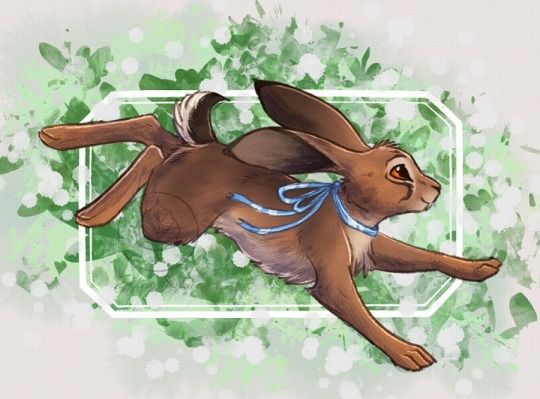
Glad Påsk! 🐇🪺🍃✨
Not a well-known fact, but I love drawing hares. Really, really love. So it’s odd that I almost never do it - I don’t know why it’s sort of turned out that way? But I did manage to revive my annual tradition of drawing an Easter hare for this season, and I’m really very pleased about that 😌
Hope you have a nice holiday, all who celebrate!
6 notes
·
View notes
Text
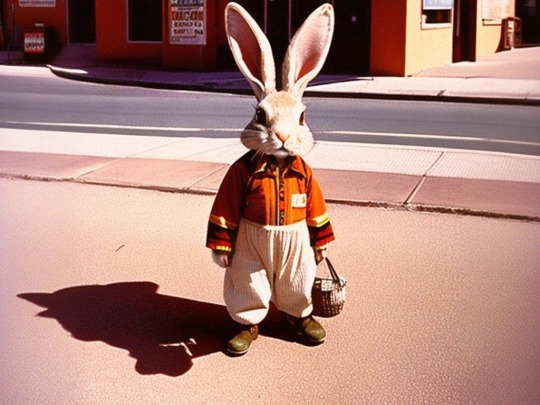
Easter... Hare? Easter Desert Hare? Ok. Why not? Does Easter Hare like Easter ham? Probably not. Ok, spread your eggs! Then we'll find them!
#easter#hare#desert hare#easter hare#easter bunny#easter basket#animals#animal art#anthropomorphic#cute#art#artwork#ai art#ai artwork#fantasy art#surrealism#ai photography
1 note
·
View note
Text
Tales of the Easter Bunny and other creepy things
Hello, my Freaky Darlings! Happy chocolate bunny day! Whether you’re in the northern hemisphere and enjoying the beginning of spring or in the south experiencing the beginnings of autumn, I hope you enjoy some chocolaty goodness. Personal Shit Since it’s Easter, I have a special offer for those who get their ebooks on Google Play. The first 500 readers can grab Shadows with 50% off until the 8th…

View On WordPress
0 notes
Text

#angel gabby#angel hare#internet series#niche#my art#my artwork#digital art#artists on tumblr#bunny#the easter patch#analog wholesome#analog horror
97 notes
·
View notes
Text

Happy Easter!
252 notes
·
View notes
Text

Last stream I drew fate characters as bunnies on request! It was a lot of fun, and I'm probably going to be opening up a commission type like this over on my Ko-fi soon.
#fgo#Asterios#Arjuna#Taigong wang#Morgan#Arthur#bunny#rabbit#hare#animal art#art#my art#illustration#digital art#request stream#artists on tumblr#fate grand order#fate grand bunny#it was a bunny themed stream since Easter was coming up#portfolio
185 notes
·
View notes
Text

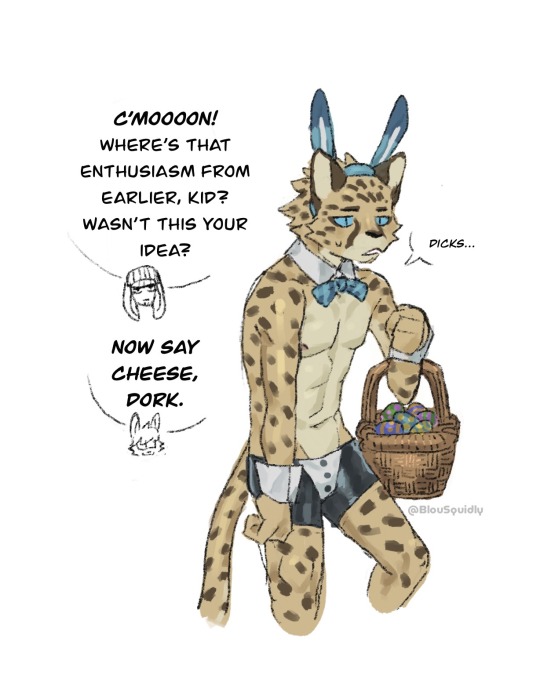
He thought he’d really talk them into it lol
Easter 2024 comic (starring my ocs)
#anthro#furryart#hare furry#furry cheetah#character design#bunny suit#easter#male nudity#male abs#death stare#original comic
105 notes
·
View notes
Photo

Gizmek Inaba, the Hopping Hare of Hakuto
414 notes
·
View notes
Text

Little Hare - Erica Scheper , 2022.
Dutch, b. 1974 -
Oil on panel , 17.5 x 15 cm.
374 notes
·
View notes
Text
The March Madness timelapse 😊💚
112 notes
·
View notes
Photo

well, do you?
68 notes
·
View notes
